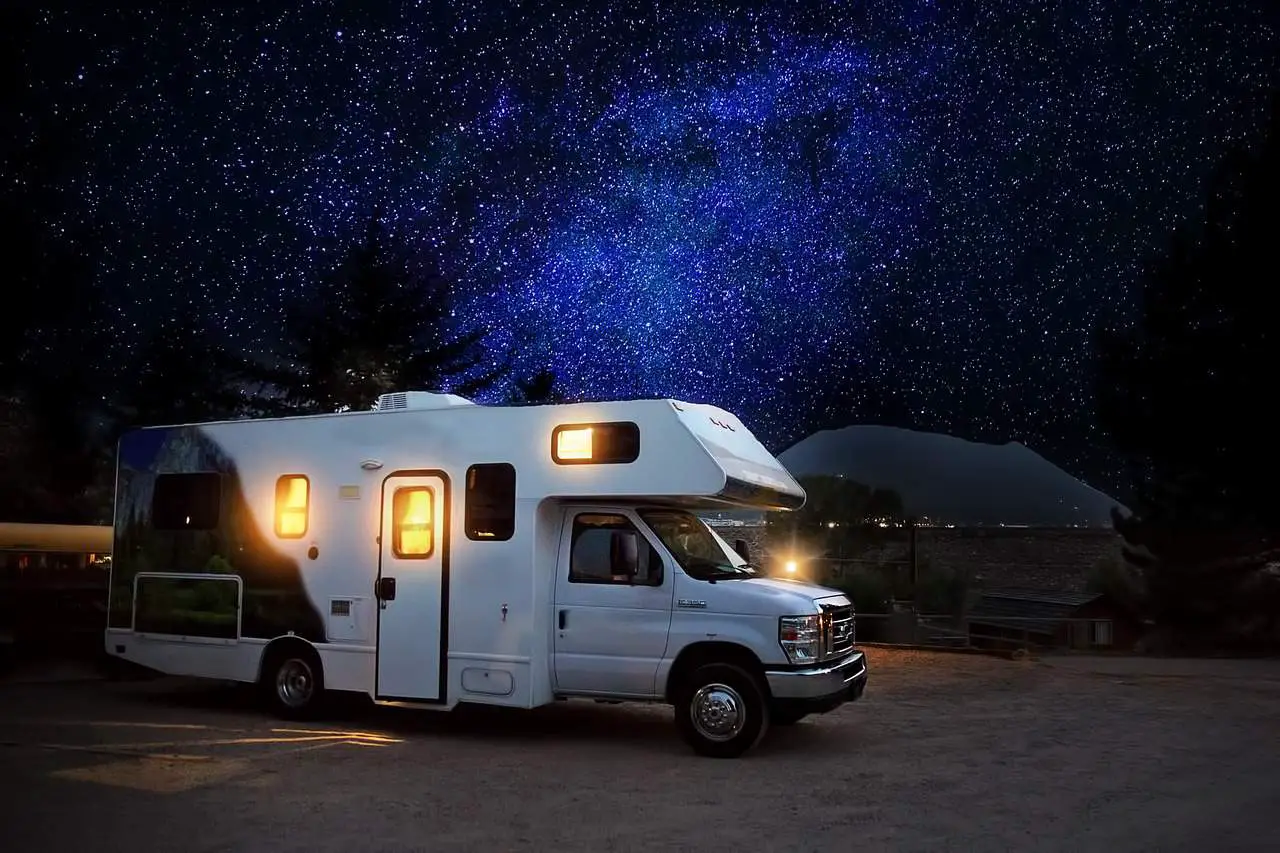The prospect of taking to the road full-time is undeniably appealing, even for families with young children. However, not every RV is up for this challenge.
Below are some items that need to be taking into consideration before making the best choice for your needs.
- Newmar Dutch Star
- Airstream Classic
- Northwood Arctic Fox
How To Choose The Right RV
While everyone’s situation is different, there are certain baseline features you can be on the lookout for. Once you’re familiar with the basics, it will be easier to choose the RV that’s right for your family.
Understanding The Different Types
The RV types listed below are the ones most conducive to full-time living. Campers and conversion vans are also available, but they’re a better choice for occasional camping trips.
Motor Homes
This class of RV blends comfort and durability—two excellent perks if you’re planning on making the vehicle your everyday home.
Because the cab is located inside the motor home, however, they’re also somewhat tricky to drive. They’re also exceptionally heavy, with a high center of gravity.
If you don’t have a great deal of experience driving big vehicles, you might be better off choosing a fifth wheel or a travel trailer instead.
Fifth Wheels
These towable RV units are more lightweight and maneuverable, owing to the fact that they contain neither engines nor generator equipment.
Their affordability and ease of transport make them an appealing choice for first-timers or individuals who will park it a not tow very often. Bear in mind, though, that a fifth wheel probably won’t last as long as a comparably-sized motor home.
Travel Trailers
Like fifth wheels, travel trailers are built to be towed behind vehicles. But are typically smaller and less bulky making them more manageable to tow and park.
Although travel trailers can contain plenty of attractive amenities, they tend to be less durable than motor homes.
Construction
When considering an RV for purchase, inspect it from the bottom up. Flooring should be easy to clean and made of sturdy, stable material, such as laminate flooring.
Similarly, furniture needs to be durable enough to withstand everyday use (heavy-duty steel framing is preferable). Look for dual-pane windows—these will help to insulate the interior against noise as well as weather.
Size
It can be hard to find an RV that’s relatively easy to drive while still being comfortable enough to live in full time or finding a trailer that is large enough that you are capable of towing with your vehicle.
With this in mind, you should confine your search to motorhomes measuring 36 to 40 feet in length.
But, if you are looking at travel trailers, depending on your family size, we would recommend searching for trailers measuring 30 to 36 feet in length.
Anything smaller, and the living space will be too cramped while you’re in transit, while larger units might be intimidating to the driver.
Don’t be tempted to paste over the issue by purchasing a unit with multiple slide rooms—these are accessible only when the vehicle is parked, which isn’t practical if you’re spending a great deal of time on the road in a motorhome.
However, they are a great feature if you are planning on living in a travel trailer.
Layout
It’s important for the space inside the coach to flow naturally. Otherwise, you’ll run the risk of feeling claustrophobic. Make sure the furniture is configured in a way that will make it easy for family members to pass through without bumping into each other.
Minimalist furniture and efficient storage space can go a long way toward achieving this goal.
Large windows will make the interior feel larger than it really is. If you use blinds instead of heavy curtains, you’ll open up the space even more.
Price
Patience is the best gift you can give yourself when shopping for an RV. If you regularly scour the market, visit RV shows, and open yourself up to the possibility of buying an older, used model, you can find some exceptional deals.
Although it’s possible to spend upwards of one million dollars on a brand-new, elegant coach, the budget-conscious should consider paying cash for a well-loved unit that’s had time to prove its worth mettle.
Of course, in this case, the initial purchase is only the beginning. See How Much Does It Cost To Live Full Time In An RV, below, for more input on this matter.
How Much Does It Cost To Live Full Time In An RV?
The answer to this question varies dramatically, depending on your situation. We’ll try to keep it as simple as possible without leaving anything out.
- Loan Payment—if you took out a vehicle loan to buy the RV, then this is the first and most obvious expense you’ll have. If you paid cash, bravo—you won’t have to worry about this step.
- Gas—Set your budget depending on how often you plan to drive. Do you intend to spend most days on the road, stopping only at night? Or will you be setting up camp for weeks at a time?
- Campground Fees—This aspect is difficult to plan for, as it can vary widely from campground to campground. If you know for sure that you’ll be spending a lot of time in a certain area, see if any local campgrounds offer annual passes or other long-term specials.
- Insurance—Most motor homes cost about $500 a year to insure. Travel trailers and fifth wheels can be covered for even less—around $250 per year.
- Gas—Depending on how much you drive, you can expect to spend about $200 to $500 per month on gas when you RV full time. The cost may also vary depending on whether you have a motor home or a towable, but the number will likely still be in this ballpark.
- Utility Bills—Set a budget for propane, electricity, phone, and Internet costs. You’ll probably need to fill your propane tank about once a month. Happily, Wi-Fi and electricity are included in many campground fees.
- Groceries—This amount shouldn’t differ overmuch from what you usually spend at home. Typically, you can feed a family of four for about $600-$800 per month.
- Maintenance and Repairs—Set aside $100 a month for maintenance, both scheduled and unscheduled. It’s better to have the money on hand than to derail your trip on account of a broken water pump or failed transmission.
- Tolls—Keep a roll of quarters ($10) handy for toll highways, and replenish the supply as needed.
- Incidentals—This fund can be used to cover entertainment expenses, as well as tools and other miscellaneous items that aren’t listed above.
For budget management tips, take a look at this YouTube testimonial.
How Do You Prepare An RV For Full-Time Living?
First of all, let your insurance company know that you’re planning on using your RV as your main residence. In addition to adjusting the cost of your premium, they can give you advice regarding the coverage of your belongings (as opposed to the vehicle itself).
Also, don’t forget to make arrangements for your bills and other mail. Some people arrange to pay all of their bills online, but mail forwarding services can be a great asset as well.
Next, you’ll have to make sure the RV contains all of your basic daily necessities. Fortunately, these can take up far less space than we think.
Be prepared to pare down your lifestyle—that’s one of the reasons you’re making this switch, after all. Just make sure to take along enough decorations and knickknacks to make the space feel like home.
Suggestions On The Best RV For Full-Time Family Living
Newmar Dutch Star
This motor home has plenty of space, with the option of multiple furniture configurations to help make it your own. Be forewarned that the gas mileage is on the low side and that maintenance tends to be costly.
These amazing vehicles are great for those on the move and would be traveling to different destinations. But keep in mind that you will most likely need to be towing a vehicle behind it so you will have something to venture out in after it’s parked.
Airstream Classic
The older versions of this iconic silver towable can represent a great value for budget-conscious shoppers.
When it comes to size, you’ll have plenty of options. The kitchen space is particularly impressive but keeps in mind that these are not offered with any side outs.
Not having slide outs does have its benefits such as easier maintenance and less things to break which can be a great thing.
Northwood Arctic Fox
An appealing and well-insulated fifth wheel camper, with eye-catching extras such as vaulted ceilings and built-in skylights.
5fth wheels usually have a great master bed area which makes them perfect for couples that like having the separated bedroom area.
They also have nice big slide outs and a ton of storage for all your items making them a great choice.
Good luck, and happy camping.
Check out our article on: Best Travel Trailers For Families Of 6: (Walkthrough Tours)

